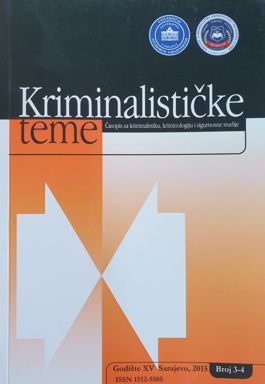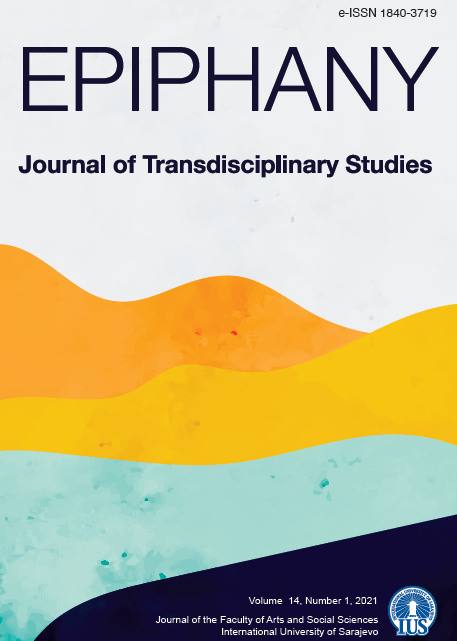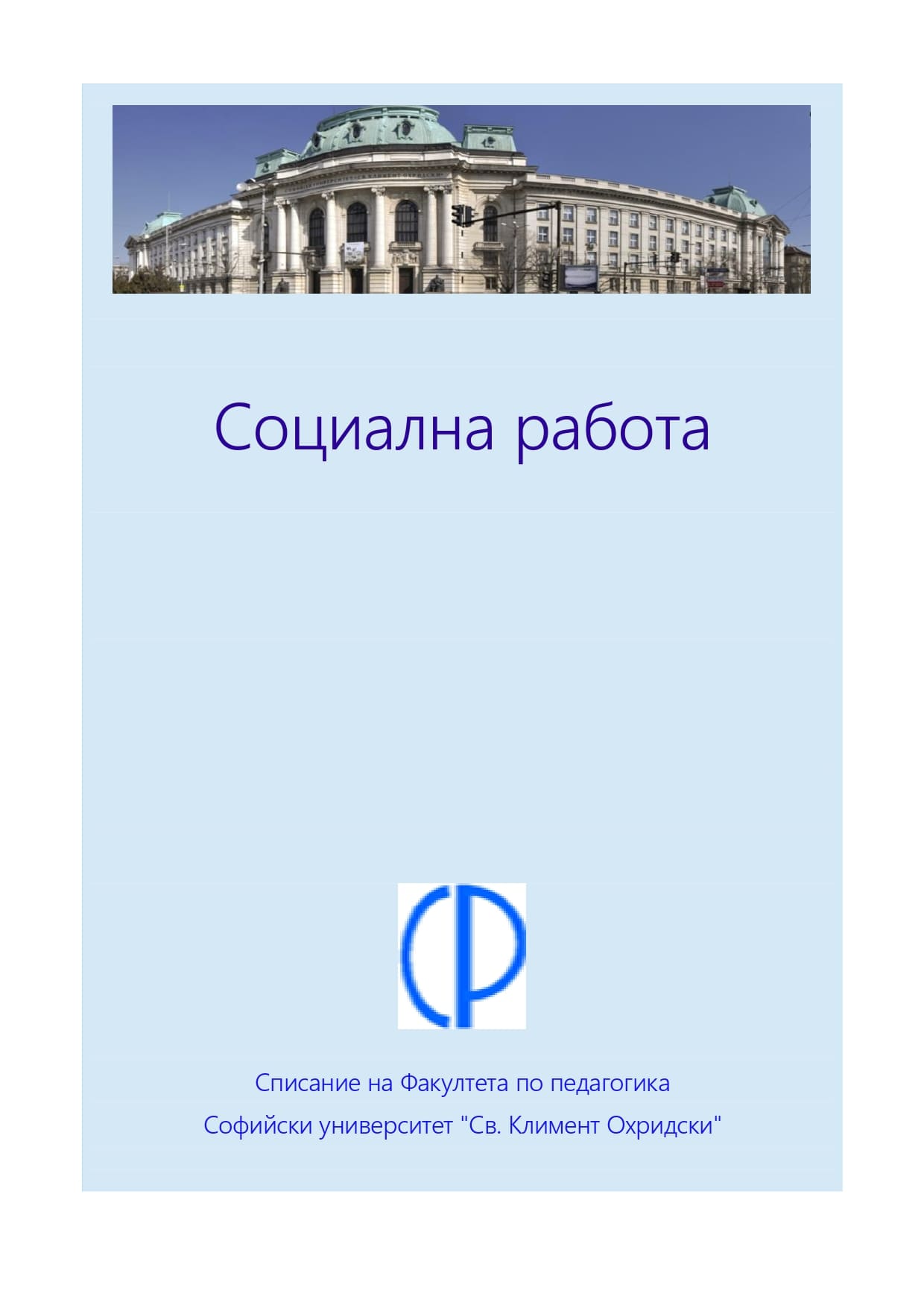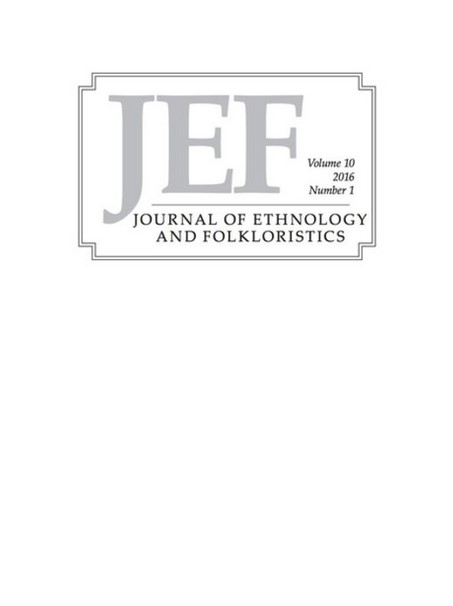
“EKONOMIKA KRIMINALA” - HAROLD WINTER
Review of: Emir Efendić - "The Economics of crime", Harold Winter, ISBN10:O-415-77173-O, Routlege (British library Cataloguing in Publication Data), 2008.
More...We kindly inform you that, as long as the subject affiliation of our 300.000+ articles is in progress, you might get unsufficient or no results on your third level or second level search. In this case, please broaden your search criteria.

Review of: Emir Efendić - "The Economics of crime", Harold Winter, ISBN10:O-415-77173-O, Routlege (British library Cataloguing in Publication Data), 2008.
More...
The article studies the topic of excessive drinking in the works of F. M. Dostoevsky in the light of the tradition of the ancient feast, or symposium. The wine offered at a symposium did not merely incline people to philosophical conversations and discussions about eternal questions, but also revealed the inner human essence, thoughts and intentions. There is ancient understanding of wine as a means of forgetting sorrows and attaining temporary joys. Excessive drinking is associated with the ancient Dionysian idea - excessive drinking at the festival of Dionysus, and the concept of metamorphosis - people lose their human essence and begin to resemble animals. In the fates of the heroes of Dostoevsky’s Poor Folk, Humiliated and Insulted, Notes from Underground, Crime and Punishment, Demons, The Brothers Karamazov, the ancient tradition is combined with the Christian understanding of a feast as reveling, and amusements at a feast, and excessive drinking as a moral transgression. On the pages of Dostoevsky’s magazine Citizen excessive drinking is equated to a serious illness, a flood, a fire, an enemy invasion, that is, to a catastrophe that affects the Russian people. The ancient tradition allows to reveal additional meanings in Dostoevsky’s interpretation of the topic of excessive drinking.
More...
Since harmful alcohol consumption among university students still presents a significant problem, our team of researchers has conducted this study to add and contribute to the current research findings regarding this social issue. The study, conducted at universities in the Turkish Republic of Northern Cyprus (TRNC), included 200 students aged 18 to 65. The research used a quasi-experimental design, employing an assessable study technique to evaluate data and generalize findings from the sample of the target population. Furthermore, quantitative research was used to determine the correlation between the variables. The correlation of AUDIT, MAST, R-MET and MCQ-30 subscales was found according to the socio-demographic characteristics of the participants. As predicted by our hypothesis, the investigation of the link between alcohol use, metacognition, and social cognition showed that alcohol drinkers had lower social cognition than non-alcohol ones. Morover, according to the results, alcohol consumption is linked to impairments in social cognition and metacognition.
More...
Objectives. This literature review aimed to reveal the relationship between psychological factors such as anxiety, depression, stress, emotionality and aggression on the one hand, and irrational alcohol consumption and risky sexual activity on the other hand, in students (19-25 years) and adjacent age groups. Material and methods. The study was conducted by analyzing the literature published between 2010 and 2020. The search was conducted in Romanian and English, in 9 international publications, by the following key phrases and terms, separately or in combination: anxiety, depression, stress, emotionality, aggressiveness, alcohol consumption, drinking motives, binge drinking, sexual behavior, risky sex. Results. Applying repeated exclusion criteria, 31 articles remained in the analysis. Among these, risk behaviors were rarely analyzed in connection with psychological factors. Most studies that investigate risky behaviors regarding alcohol consumption and sexual activity, address them according to gender, educational level, age groups. Women were more prone to anxiety and depression, but also to show more psychological aggression compared to men who showed more physical aggression, even in sexual activity. Researches included aggression as a behavioral trait, and emotionality has been used as a variable in studies to validate standardized tools. Irrational alcohol consumption has been significantly associated with risky sexual activity and various forms of aggression. Conclusions. The risk of manifesting and developing depressive and anxiety symptoms is higher in victims of aggression, in people with risky sexual activity, and in consumers of irrational alcohol. In students and young people, stress has high values, contributing to the tendency towards risky behaviors. It is necessary to promote successful coping strategies and mechanisms, both in individual and group level, as well as the development of prevention strategies and therapeutic procedures to improve the listed risk behaviors.
More...
The article discusses the problem of sociopolitical control over the market for illicit psychoactive substances (PAS) on the Russian darknet in light of the needs that this market, on the one hand, promises to satisfy and, on the other hand, constructs itself, stimulating consumption communities. The transformation of goods into market commodities is conceptualized as a social process. Market intermediaries sharply detect the deficits and consumers’ cultural attitudes and, relying on them, firstly, normalize the demand for their product and, secondly, invest in the development of consumer capital, which helps buyers make informed choices even where the quality of market product is uncertain, unpredictable, and hard to assess prior to consumption. To reconstruct and evaluate the marketing efforts of online stores selling illicit substances, the article analyzes 1,000 descriptions of products available on the cannabinoid market, collected using the parsing method from an online marketplace on the Russian darknet, as well as consumer reviews of these products. The article demonstrates that the shadow market for natural surfactants normalizes its product by categorizing it as a natural medicine that allows consumers to influence their physical and psychological conditions not just for individual hedonistic purposes but to achieve positive social effects. Cannabinoid products are marketed as a source of new experiences that contribute to self-knowledge, creativity, emancipation, and substantive interaction with other people. In a medicalized society of emotions, the consumer is offered the image of a taster and gourmet, able to appreciate the results of the art of cannabis growing.
More...
The literature suggests that sex offenders are more at risk of relapse and how much treatment pathways are needed to prevent it. Furthermore, the picture of predisposing factors connected to relapse appears complex. Therefore, the aim of this work is to verify the framework of social-cognitive risk factors connected to relapse in sex offenders. Participants in the study are 128 male sex offenders. The age range of the participants goes from 21 to 75 years (M = 41.74; SD = 13.45). Participants were given self-report questionnaires to evaluate cognitive distortions towards children and towards the right to sexuality, the Hanson Sex Attitude Questionnaire; cognitive distortions towards women, the Vindictive Rape Attitude Questionnaire; the mechanisms of moral disengagement, the Moral Disengagement Scale; furthermore, based on the grid of De Leo and colleagues, any adverse conditions (abuse, mistreatment, poverty, substance abuse, institutionalization) during childhood and/or adolescence were identified. Recidivism, on the other hand, was examined by asking participants if they had been convicted several times of the same crime and verifying this information through their files. The results showed that institutionalization, abuse, cognitive distortions towards women, and the mechanism of attributing blame to the victim can be relevant risk factors associated with relapse. The picture that emerged could suggest how the occurrence in a context of institutionalization during childhood could evidently represent an adverse condition during individual development that acts as a predisposing factor for the risk of relapse; in fact, it is possible to hypothesize that this condition may be linked to experiences of neglect. In the direction, the cognitive distortions towards women and the mechanism of attributing guilt to the victim represented the fulcrum of the deviant cognitive scheme capable of legitimizing the activation of violent and abusive behavior.
More...
The subject of the study is the treatment of PTSD with the use of MDMA as a method of counteracting the incidence of suicide. The discussion is carried out in the context of Polish law. The method used in the paper involves an analysis of the law in force, aided by M. Zieliński’s derivative concept of legal interpretation. The author of the study has established that: 1) PTSD may constitute a source of a threat to human life and health where persons might take their own lives; 2) PTSD can be successfully treated with MDMA; 3) Polish law does not allow the use of MDMA in the treatment of PTSD; 4) Polish law provides for criminal liability for possession of MDMA/ecstasy.
More...
This paper addresses the question of how the Taliban takeover of power in Afghanistan impacts Iran’s national security. The paper aims to offer an enhanced understanding of the current developments in Afghanistan and argues that the advancement of Taliban forces as well as the Islamic state’s territorial expansion inside Afghanistan poses a genuine threat to the Iranian state’s territorial integrity and sovereignty. In terms of Iran’s human security, enhanced terrorism, drug, and human trafficking within the state will probably impact the physical security of the Iranian citizens as a result of the Afghan crisis. Using a constructivist methodology, the paper also shows the importance of the national identity of Iran for the construction of security policy which is thus imperative not only for a better understanding of Iran’s approach to security but also for creating conducive steps towards reconciliation between Iran and the international community.
More...
Social media is used at very high rates among young people not only in Europe and other developed countries but also developing and people from almost all generations have started to use social media. The use of social media has become an addiction regardless of country and changed the daily behaviour of users. Studies related to social media addiction are generally done on youth. It is observed that middle-aged and older individuals started to have engaged in social media. Therefore, the lack of research related to social media addiction of middle-aged individuals and over has made this study important. The aim of this study is to understand the tendencies to use social media as people get older. In the study, a survey was conducted on people aged between 24 and 49, and on people aged 50 and over; the goal was to understand the difference between the two age groups. Social Media Addiction Scale Adult Form was used in the study was conducted on a total of 650 participants. As a result of the analysis of the data, it was concluded that as the age increased, the level of social media addiction decreased but that the social media addiction levels of individuals over middle age were considerably high more than expected. As the education level increases, the virtual tolerance sub-factor increases and the risk of social media addiction increases. There is a significant relationship between participants' marital status, smartphone use and social media addiction. The use of social media in the society can be transformed into an environment that can be used in education, self expression, creativity, media literacy and integration with society by getting rid of addiction. In addition, since addiction issue is being spread in Turkey and Europe, we want to increase an awareness for individuals and policymakers.
More...
The probationer–probation officer working alliance plays an important role in the outcome of probation supervision. This study explored the development of the working alliance between probationers and probation officers in the Netherlands, from the perspective of both probationers and probation officers. More specifically, we explored the significance of different aspects of the working alliance at the start of probation supervision and after a three-month period, as well as the role played by critical incidents during the supervisory process and their subsequent effect on the working alliance. Overall, the study showed that clarity over goals and restrictions was initially the most salient issue for both parties, and that after a three-month period the working alliance evolved into a trusting relationship. Several incidents were identified, probationers identified more positive moments and less negative moments than their PO counterparts. If these types of incidents are managed accordingly by the probation officer, then they can ultimately serve to strengthen the relationship.
More...
The following paper purpose is to be analyzed theoretically and empirically techniques for enhancing motivation for change, which are eligible for implementation in the social work process with youngsters with deviant behavior. The study relies on the assumption that the model of social work, which is oriented towards the motivation for change, facilitates the process when it presents techniques encouraging change and avoids those who hold it. The motivation for change enhancement is a result of the specificity and the quality of interaction. The study was conducted in social work organizations with corrective and supportive functions mainly – shelters and transitional programs, therapeutic communities and rehabilitation programs. The article provides methodological guidelines for the possible use of techniques for enhancing motivation for change, consistent with the phases of the workflow in the social work process with youngsters with deviant behavior.
More...
Social work plays vitally important role in every moment of a drug addict's therapy. It is directed towards support of the drug addict and his family in order successful social functioning to be acheived. The article emphasizes on the specifics of social work with drug addicts. A short theoretical analysis of the different approaches of social work with that at risk target group is accomplished with particular attention to the psycho-social therapeutic approach.
More...
We trace the history of the uses of the alcoholic drink known as kumyshka among the Udmurt. Our focus is on kumyshka’s ritual uses both in public and domestic contexts in the second half of the 19th century, the early 20th century as well as the early 21st century. We suggest that kumyshka not only represents a site of resistance to the dominant religious regime, i.e. Russian Orthodoxy, but is also a tool for self-enhancement and identity making for this indigenous people in the Volga River basin in Central Russia. The consumption of kumyshka has been a frequent object of criticism in the accounts of Orthodox clergy, scholars, doctors, travellers and administrators. Most accounts reflect a moralising stance, which only occasionally reflects the local understandings behind its uses. As anthropologists working in the region, we compare these historical sources with the current practices. We discuss changes in the religious sphere as well as in gender roles related to the uses of kumyshka.
More...
Abaterea constând în consumul de alcool în incita societăţii sau la punctele de lucru nu este condiţionată de săvârşirea acesteia în timpul programului de lucru, susţinerile reclamantului cu privire la aflarea în afara orelor de program neavând nicio relevanţă sub aspectul existenţei faptei.
More...
The use of tobacco products carries with it numerous risks and problems and negatively affects the health of adolescents. Due to such influence, there is a need to react and approach the creation of a prevention program. This paper aims to compare data from different studies around the world, clarify the aspects of the use of tobacco products among the adolescent population and provide new insight into this complex problem. The research is a cross-sectional epidemiological study conducted in the period from September 2019 to March 2020 in 67 primary schools in the Republic of Srpska. The sample consists of 2,508 students aged 11 to 15 recruited by random sampling and 43 employees in 43 elementary schools. For the purposes of the research, a questionnaire for students and a questionnaire for the school administration were used, which were prepared for this study, according to the guidelines of the World Health Organization. Out of the total sample, 17.8% of students stated that both parents smoke, 15.5% of students stated that during the school year they had education about the harm of using cigarettes as part of the school program, 28.1% do not remember when they had education about above, 11.9% of students tried cigarettes and 50.3% of students stated that they do not know if there are disciplinary penalties for using cigarettes at school. The results of a survey of school employees showed that 20.9% smoke in the workplace, and 18,6% are not aware of the no-smoking policy. School children and young people represent the most vulnerable category of the population, but at the same time they also represent the greatest biological potential of society. Tobacco consumption is a serious problem in the environment in which they live, and in addition to education, schools also have an educational role, therefore they should provide a healthy, safe and stimulating environment.
More...
Addiction is a major public health and social problem. The complications of addiction can occur in the public or private sphere. In a family with substance-dependent parents, the family dynamic changes and accompanying phenomena develop that are harmful to the psychosocial development of the child, the consequences of which are visible in adulthood. Many children show an increased risk of developing emotional, social, behavioural, and cognitive-academic problems, with consequences that continue into adulthood. In present study, we examined the correlation between substance abuse in the family of origin and certain circumstances and aspects of experience in childhood (substance misuse, functionality of family life) and in adulthood (addiction, experience of personal problems and strengths, emotion regulation). The results of the study, which involved 465 participants, show that higher substance abuse in the family of origin is correlated with worse functionality of family of origin and more presence of different forms of abuse and neglect in childhood. There is also a statistically significant correlation between substance abuse in the family of origin and more substance abuse problems in adulthood, experiencing lower functionality in adulthood (more individual problems and less strengths), and more difficulties in emotion regulation. Children of addicted parents are more vulnerable to developing complications in childhood and adulthood due to the stressful circumstances of their childhood, and there is a justified and reasonable need for psychosocial and therapeutic support that will consider the areas that are most exposed and affected in these circumstances.
More...
Elderly people live real dramas because of their exclusion from social and economic life, but mostly because on several occasions they are abandoned in their old age by their own children. Moreover, once they grow older these people start confronting various health problem sand need the help of someone else almost permanently.Thus, they become dependent, experiencing strong feelings of frustration, insecurity,because of lack of control over their own lives, impatience, anger, when the care is in appropriate, guilt towards the caretaker.The activities which have taken place up to the present in favors of elderly people were sporadic and without results, and concerning abandoned, isolated, and sick old people, they were practically inexistent. The elderly has difficulties in maintaining normal living standards because of economic problems which led to the apparition of an aggravating state of poverty among them
More...
The aim of this study is to examine the relationship between childhood traumas, alexithymia and difficulty in emotion regulation in university students. Relational screening model was used in the research. The sample group of the study consists of 351 university students. 83.5% of the participants (n = 293) were women and 16.5% (n = 63) were men. Informed Voluntary Consent Form, Socio-demographic Information Form, Childhood Trauma Scale, Toronto Alexithymia Scale and Emotion Regulation Scale Short-Form were administered to the participants. Data collection was carried out online (Google Forms) through convenient sampling. Spearman Correlation Analysis and Simple Linear Regression Analysis were performed to examine the relationship and effect between non-parametric tests and socio-demographic characteristics, childhood traumas, alexithymia and emotion regulation difficulties, by looking at the normality curves in the data analysis. As a result of the research findings, a significant and positive relationship was found between the childhood traumas, alexithymia and emotion regulation difficulties of university students. In addition, it was determined that male individuals are more alexithymic than females, females are exposed to sexual abuse more than males, 24-25 age group has more difficulty in emotion regulation, and the rate of emotion regulation and alexithymia is low in the presence of a romantic relationship. It is thought that this study can contribute to the relevant literature. It is thought that the results obtained from the study will contribute to the field of clinical practice and the relevant literature.
More...
Tracy Letts is one of the best-known and most successful American playwrights of the 21st century, having won critical and popular acclaim both for his writing and acting. August: Osage County, probably his most celebrated play, premiered in 2007 and introduced the theater-going public to the dysfunctional Weston family, who reunite in a stifling, decaying Oklahoma mansion after the family patriarch’s suicide. The Westons’ familial crisis is manifested through addiction, violence, aggressiveness, adultery, rape and incest, each member having their own secrets and troubles. The present article aims, first, to examine how the characters deal with their personal crises and second, how the perceived sense of crisis and decline in the American society at large (both in a longer historical sense and in a sense contemporary to the events of the play) pushed family patriarch Beverly Weston to commit suicide out of a sense of profound hopelessness and disillusionment. Letts, by bringing familial crisis and conflict into the spotlight, shows how the disintegration of the Westons’ family ties mirrors, to a significant extent, the crumbling of the American Dream.
More...
The image of an addicted person is quite trivial: such people are perceived as uneducated and weak-willed people, losers, most likely coming from working--class and often pathological families. The ruling class uses this notion, which is seen in the current opinions on the “500+” programs or other social programs. However, the demystification of the image of a person addicted to alcohol is only the top of the iceberg – in this article, I would like to present how the social per-ceptions about alcoholics, created by liberal elites and the media serving them, affect the lives of alcoholics, their social perception and the difficulty of reaching for medical help in the fight against addiction.
More...